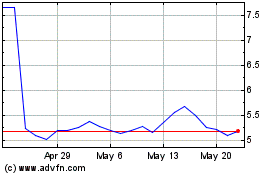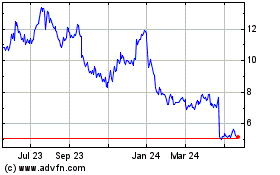Centogene N.V. (Nasdaq: CNTG), the essential life science
partner for data-driven answers in rare and neurodegenerative
diseases, today announced the discovery of a new small molecule
together with Evotec SE (Frankfurt Stock Exchange: EVT,
MDAX/TecDAX, ISIN: DE0005664809; NASDAQ: EVO). The new molecule has
the potential to treat patients with type 2 and type 3 Gaucher
disease, otherwise known as neuronopathic Gaucher disease. The
discovery has been the result of the collaborative work under the
existing drug discovery partnership which has been in place since
2020.
The Companies have now extended this collaboration for another
year, granting Evotec an R&D License for the continued
development activities. The amended agreement also provides Evotec
with an exclusive option until March 31, 2025, to determine whether
to enter a license agreement acquiring CENTOGENE’s share of the IP
generated throughout the collaboration. In exchange for such a
global exclusive license, CENTOGENE would receive an up-front fee,
milestone payments, as well as additional royalties. Further
financial details were not disclosed.
“This partnership is indicative of how we are able to
successfully leverage our expansive know-how in rare diseases as
well as the depth of the CENTOGENE Biodatabank, which in
combination with Evotec’s multi-modality platform has successfully
identified drug candidates in Gaucher disease,” said Dr. Peter
Bauer, Chief Medical and Genomic Officer at CENTOGENE.
“Importantly, together with Evotec, we have established a much
deeper understanding of neuronopathic Gaucher disease than before,
which we believe could accelerate the development of a new
life-saving treatment for these patients worldwide.”
Within their collaboration that was initiated in 2018, CENTOGENE
and Evotec have been working together to research, discover, and
develop a molecule to reduce the lysosomal molecule lyso-Gb1, which
is massively increased in patients with neuronopathic Gaucher
disease. The collaboration brought together Evotec’s leading
induced pluripotent stem cell (iPSC) platform and broad drug
discovery and development capabilities with the CENTOGENE
Biodatabank, which contains data from over 850,000 patients,
including patient-derived iPSC lines and proprietary translational
biomarkers.
“We are excited that our highly complementary partnership with
CENTOGENE has yielded a first potential treatment for Gaucher
disease,” said Dr. Cord Dohrmann, Chief Scientific Officer of
Evotec SE. “The identified molecule is the result of combining
CENTOGENE’s real-world, data-based, global rare disease platform
with Evotec’s broad drug discovery and development capabilities. We
look forward to exploring further development options for the
promising molecule to deliver a much-needed option for an
underserved patient population.”
The collaboration has achieved significant success in
preclinical studies. In vivo pharmacodynamics and pharmacokinetics
studies in animal models have demonstrated high brain penetration
and metabolic stability of the drug candidate. This new molecule is
now positioned to enter the next stage of R&D, which Evotec is
currently pursuing.
About the Molecule Discovery
Under the partnership, the Companies leveraged Evotec’s high
throughput screening platform to test more than 250,000 chemically
diverse compounds, with a high prediction of central nervous system
(CNS) penetration. CENTOGENE then initiated a validation process of
these potential drug candidates. Using the Company’s iPSC-derived
macrophage cell model derived from real neuronopathic Gaucher
patients, CENTOGENE used its proprietary translational biomarker as
a readout for the efficacy and potency of this potential new drug
candidate.
About Neuronopathic Gaucher Disease
Gaucher disease is category of rare, inherited metabolic
disorders. Due to the lack of the enzyme glucocerebrosidase, sugar
containing fat molecules called glycolipids accumulate in the
cell’s lysosomes. The symptoms of Gaucher disease include an
abnormally enlarged liver and/or spleen (hepatosplenomegaly),
anemia and blood cells promoting clotting (thrombocytopenia) and
skeletal abnormalities. The symptoms vary greatly from patient to
patient, causing a challenge for clinical development of novel
therapeutics in the space. Gaucher disease is categorized into
three types (Type 1, 2, and 3). Types 2 and 3 Gaucher disease are
neuronopathic forms of the disorder due to symptoms linked to the
Central Nervous System (CNS) associated with the highest levels of
lyso-Gb1 in tissues and blood. These neuronopathic forms of Gaucher
disease are a relatively rare condition among all patients affected
by the disease. To date, the neurological aspects of the disease
present an unknown future regarding quality of life and life
expectancy. Approximately 1 in 57,000 people or 125,000 worldwide
have Gaucher disease.
About EVOTEC SE
Evotec is a life science company with a unique business model
that delivers on its mission to discover and develop highly
effective therapeutics and make them available to the patients. The
Company’s multimodality platform comprises a unique combination of
innovative technologies, data and science for the discovery,
development, and production of first-in-class and best-in-class
pharmaceutical products. Evotec provides high value pipeline
co-creating partnerships and solutions to all Top 20 Pharma and
over 800 biotechnology companies, academic institutions, as well as
other healthcare stakeholders. Evotec has strategic activities in a
broad range of currently underserved therapeutic areas, including
e.g. neurology, oncology, as well as metabolic and infectious
diseases. Within these areas of expertise, Evotec aims to create
the world-leading co-owned pipeline for innovative therapeutics and
has to-date established a portfolio of more than 200 proprietary
and co-owned R&D projects from early discovery to clinical
development. Evotec operates globally with more than 5,000 highly
qualified people. The Company’s 17 sites offer highly synergistic
technologies and services and operate as complementary clusters of
excellence. For additional information please go to www.evotec.com
and follow us on X/Twitter @Evotec and LinkedIn.
About CENTOGENE
CENTOGENE’s mission is to provide data-driven, life-changing
answers to patients, physicians, and pharma companies for rare and
neurodegenerative diseases. We integrate multiomic technologies
with the CENTOGENE Biodatabank – providing dimensional analysis to
guide the next generation of precision medicine. Our unique
approach enables rapid and reliable diagnosis for patients,
supports a more precise physician understanding of disease states,
and accelerates and de-risks targeted pharma drug discovery,
development, and commercialization.
Since our founding in 2006, CENTOGENE has been offering rapid
and reliable diagnosis – building a network of approximately 30,000
active physicians. Our ISO, CAP, and CLIA certified multiomic
reference laboratories in Germany utilize Phenomic, Genomic,
Transcriptomic, Epigenomic, Proteomic, and Metabolomic datasets.
This data is captured in our CENTOGENE Biodatabank, with over
850,000 patients represented from over 120 highly diverse
countries, over 70% of whom are of non-European descent. To date,
the CENTOGENE Biodatabank has contributed to generating novel
insights for more than 300 peer-reviewed publications.
By translating our data and expertise into tangible insights, we
have supported over 50 collaborations with pharma partners.
Together, we accelerate and de-risk drug discovery, development,
and commercialization in target and drug screening, clinical
development, market access and expansion, as well as offering
CENTOGENE Biodata Licenses and Insight Reports to enable a world
healed of all rare and neurodegenerative diseases.
To discover more about our products, pipeline, and
patient-driven purpose, visit www.centogene.com and follow us on
LinkedIn.
Forward-Looking Statements
This press release contains “forward-looking statements” within
the meaning of the U.S. federal securities laws. Statements
contained herein that are not clearly historical in nature are
forward-looking, and the words “anticipate,” “believe,”
“continues,” “expect,” “estimate,” “intend,” “project,” “plan,” “is
designed to,” “potential,” “predict,” “objective” and similar
expressions and future or conditional verbs such as “will,”
“would,” “should,” “could,” “might,” “can,” and “may,” or the
negative of these are generally intended to identify
forward-looking statements. Such forward-looking statements involve
known and unknown risks, uncertainties, and other important factors
that may cause CENTOGENE’s actual results, performance, or
achievements to be materially different from any future results,
performance, or achievements expressed or implied by the forward-
looking statements. Such risks and uncertainties include, among
others, negative economic and geopolitical conditions and
instability and volatility in the worldwide financial markets,
possible changes in current and proposed legislation, regulations
and governmental policies, pressures from increasing competition
and consolidation in our industry, the expense and uncertainty of
regulatory approval, including from the U.S. Food and Drug
Administration, our reliance on third parties and collaboration
partners, including our ability to manage growth, execute our
business strategy and enter into new client relationships, our
dependency on the rare disease industry, our ability to manage
international expansion, our reliance on key personnel, our
reliance on intellectual property protection, fluctuations of our
operating results due to the effect of exchange rates, our ability
to streamline cash usage, our continued ongoing compliance with
covenants linked to financial instruments, our requirement for
additional financing, and our ability to continue as a going
concern, or other factors. For further information on the risks and
uncertainties that could cause actual results to differ from those
expressed in these forward-looking statements, as well as risks
relating to CENTOGENE’s business in general, see CENTOGENE’s risk
factors set forth in CENTOGENE’s Form 20-F filed on May 16, 2023,
with the Securities and Exchange Commission (the “SEC”) and
subsequent filings with the SEC. Any forward-looking statements
contained in this press release speak only as of the date hereof,
and CENTOGENE specifically disclaims any obligation to update any
forward-looking statement, whether as a result of new information,
future events, or otherwise.
CONTACTS
Evotec
Gabriele HansenSVP, Head of Global Corporate Communications+49
160 7164389gabriele.hansen@evotec.com
Hinnerk RohwedderDirector of Global Corporate Communications +49
151 40704843hinnerk.rohwedder@evotec.com
CENTOGENE
Melissa HallCorporate Communications Press@centogene.com
Lennart StreibelInvestor Relations IR@centogene.com
Evotec (NASDAQ:EVO)
Historical Stock Chart
From Dec 2024 to Jan 2025

Evotec (NASDAQ:EVO)
Historical Stock Chart
From Jan 2024 to Jan 2025
